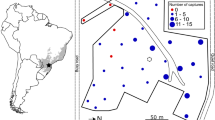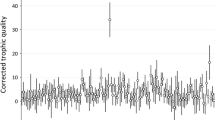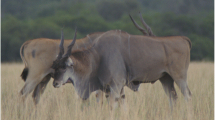Abstract
Sexual segregation is widely reported among sexually dimorphic species and generally attributed to intraspecific competition. Prey diversity and human activities can reinforce niche segregation by increasing resource heterogeneity. Here, we explored trophic and spatial sexual segregation in the only avian scavenger that exhibits pronounced sexual size dimorphism (up to 50% difference in body mass) and a highly despotic social system, the Andean condor (Vultur gryphus). We predicted that larger and dominant males would exclude smaller and subordinate females from high-quality resources, leading to sexual segregation particularly in human-dominated landscapes showing increased prey diversity. We compared resource use between females and males across six sites in Argentina featuring a range of prey diversity via stable isotopes analysis of molted feathers (n = 141 individuals). We then focused on two sites featuring contrasting levels of prey diversity and quantified assimilated diet via stable isotopes and space use via GPS monitoring (n = 23 and 12 tagged individuals). We found no clear differences in isotopic niche space, individual variation in isotopic signature, or assimilated diet between females and males. However, there were differences in foraging locations between sexes, with females apparently using areas of fewer food resources more frequently than males. Local conditions defined the dynamics of fine-scale sexual differences in foraging sites; yet, unpredictable and ephemeral carrion resources likely prevent segregation by sexes at the landscape scale. Our study highlights complex dynamics of sexual segregation in vultures and the relevancy of analyses under multiple spatial–temporal scales to explore segregation in social species.




Similar content being viewed by others
Code availability
Sample code has been provided in the supplementary material S2.
References
Alarcón PAE, Morales JM, Donázar JA et al (2017) Sexual-size dimorphism modulates the trade-off between exploiting food and wind resources in a large avian scavenger. Sci Rep 7:11461. https://doi.org/10.1038/s41598-017-11855-0
Ballejo F, Plaza P, Speziale KL et al (2021) Plastic ingestion and dispersion by vultures may produce plastic islands in natural areas. Sci Total Environ 755:142421. https://doi.org/10.1016/j.scitotenv.2020.142421
Baylis AMM, Orben RA, Costa DP et al (2016) Sexual segregation in habitat use is smaller than expected in a highly dimorphic marine predator, the southern sea lion. Mar Ecol Prog Ser 554:201–211. https://doi.org/10.3354/meps11759
Bearhop S, Waldron S, Votier SC, Furness RW (2002) Factors that influence assimilation rates and fractionation of nitrogen and carbon stable isotopes in avian blood and feathers. Physiol Biochem Zool 75:451–458. https://doi.org/10.1086/342800
Bennett RE, Rodewald AD, Rosenberg KV (2019) Overlooked sexual segregation of habitats exposes female migratory landbirds to threats. Biol Conserv 240:108266. https://doi.org/10.1016/j.biocon.2019.108266
Bison M, Ibanez S, Redjadj C et al (2015) Upscaling the niche variation hypothesis from the intra- to the inter-specific level. Oecologia 179:835–842. https://doi.org/10.1007/s00442-015-3390-7
Bolnick DI, Svanbäck R, Fordyce JA et al (2003) The ecology of individuals: Incidence and Implications of individual specialization. Am Nat 161:1–28. https://doi.org/10.1086/343878
Calenge C (2006) The package “adehabitat” for the R software: a tool for the analysis of space and habitat use by animals. Ecol Modell 197:516–519. https://doi.org/10.1016/j.ecolmodel.2006.03.017
Canty A, Ripley B (2019) boot: Bootstrap R (S-Plus) Functions. R package version 1.3-22. https://CRAN.R-project.org/package=boot
Catry P, Phillips RA, Croxall JP (2005) Sexual segregation in birds: patterns, processes and implications for conservation. In: Neuhaus P, Ruckstuhl KE (eds) Sexual segregation in vertebrates, ecology of the two sexes. Cambridge University Press, Cambridge, pp 351–378
Catry T, Alves JA, Gill JA et al (2014) Individual specialization in a shorebird population with narrow foraging niche. Acta Oecol 56:56–65. https://doi.org/10.1016/j.actao.2014.03.001
Catry I, Catry T, Alho M et al (2016) Sexual and parent-offspring dietary segregation in a colonial raptor as revealed by stable isotopes. J Zool 299:58–67. https://doi.org/10.1111/jzo.12324
Cleasby IR, Wakefield ED, Bodey TW et al (2015) Sexual segregation in a wide-ranging marine predator is a consequence of habitat selection. Mar Ecol Prog Ser 518:1–12. https://doi.org/10.3354/meps11112
Cucherousset J, Villéger S (2015) Quantifying the multiple facets of isotopic diversity: new metrics for stable isotope ecology. Ecol Indic 56:152–160. https://doi.org/10.1016/j.ecolind.2015.03.032
De Lisle SP, Rowe L (2015) Ecological character displacement between the sexes. Am Nat 186:693–707. https://doi.org/10.1086/683775
Díaz S, Acosta A, Cabido M (1994) Community structure in montane grasslands of central Argentina in relation to land use. J Veg Sci 5:483–488. https://doi.org/10.2307/3235974
Donadio E, Buskirk S, Novaro A (2012) Juvenile and adult mortality patterns in a vicuña (Vicugna vicugna) population. J Mammal 93:1536–1544. https://doi.org/10.1644/12-MAMM-A-062.1
Donázar JA, Travaini A, Ceballos O et al (1999) Effects of sex-associated competitive asymmetries on foraging group structure and despotic distribution in Andean condors. Behav Ecol Sociobiol 45:55–65. https://doi.org/10.1007/s002650050539
Duclos M, Sabat P, Newsome SD et al (2020) Latitudinal patterns in the diet of Andean condor (Vultur gryphus) in Chile: contrasting environments influencing feeding behavior. Sci Total Environ 741:140220. https://doi.org/10.1016/j.scitotenv.2020.140220
Farr T, Rosen PA, Caro E et al (2007) The shuttle radar topography mission. Rev Geophys 45:RG2004. https://doi.org/10.1029/2005RG000183
Ferguson-Lee J, Christie DA (2001) Raptors of the world. Houghton Mifflin Harcour, Boston
Gangoso L, Lambertucci SA, Cabezas S et al (2016) Sex-dependent spatial structure of telomere length in a wild long-lived scavenger. Ecosphere 7:e01544. https://doi.org/10.1002/ecs2.1544
Gil MA, Hein AM, Spiegel O et al (2018) Social information links individual behavior to population and community dynamics. Trends Ecol Evol 33:535–548. https://doi.org/10.1016/j.tree.2018.04.010
Guido JM, Alarcón PAE, Donázar JA et al (2020) The use of biosphere reserves by a wide-ranging avian scavenger indicates its significant potential for conservation. Environ Conserv 47:22–29. https://doi.org/10.1017/S0376892919000304
Hijmans RJ (2019) Introduction to the "Raster" package. R package version 2.8-19. https://CRAN.R-project.org/package=raster
Jackson AL, Inger R, Parnell AC, Bearhop S (2011) Comparing isotopic niche widths among and within communities: SIBER—stable isotope Bayesian ellipses in R. J Anim Ecol 80:595–602. https://doi.org/10.1111/j.1365-2656.2011.01806.x
Jaeger A, Blanchard P, Richard P, Cherel Y (2009) Using carbon and nitrogen isotopic values of body feathers to infer inter- and intra-individual variations of seabird feeding ecology during moult. Mar Biol 156:1233–1240. https://doi.org/10.1007/s00227-009-1165-6
Jones AW, Post DM (2016) Does intraspecific competition promote variation? A test via synthesis. Ecol Evol 6:1646–1655. https://doi.org/10.1002/ece3.1991
Kirby R, Alldredge MW, Pauli JN (2016) The diet of black bears tracks the human footprint across a rapidly developing landscape. Biol Conserv 200:51–59. https://doi.org/10.1016/j.biocon.2016.05.012
Kruschke JK (2015) Doing Bayesian data analysis—a tutorial with R, JAGS, and Stan, 2nd edn. Academic Press, London, United Kingdom
Kurle CM, Finkelstein ME, Smith KR et al (2013) Discrimination factors for stable isotopes of carbon and nitrogen in blood and feathers from Chicks and Juveniles of the California Condor. Condor 115:492–500. https://doi.org/10.1525/cond.2013.120107
Lambertucci SA, Mastrantuoni OA (2008) Breeding behavior of a pair of free-living Andean Condors. J F Ornithol 79:147–151. https://doi.org/10.1111/j.1557-9263.2008.00156.x
Lambertucci SA, Trejo A, Di Martino S et al (2009) Spatial and temporal patterns in the diet of the Andean condor: ecological replacement of native fauna by exotic species. Anim Conserv 12:338–345. https://doi.org/10.1111/j.1469-1795.2009.00258.x
Lambertucci SA, Carrete M, Donázar JA, Hiraldo F (2012) Large-scale age-dependent skewed sex ratio in a sexually dimorphic avian scavenger. PLoS ONE 7:e46347. https://doi.org/10.1371/journal.pone.0046347
Lambertucci SA, Navarro J, Sanchez Zapata JA et al (2018) Tracking data and retrospective analyses of diet reveal the consequences of loss of marine subsidies for an obligate scavenger, the Andean condor. Proc Biol Sci 285:20180550. https://doi.org/10.1098/rspb.2018.0550
Layman CA, Quattrochi JP, Peyer CM, Allgeier JE (2007) Niche width collapse in a resilient top predator following ecosystem fragmentation. Ecol Lett 10:937–944. https://doi.org/10.1111/j.1461-0248.2007.01087.x
MacArthur RH (1958) Population ecology of some warblers of northeastern coniferous forests. Ecology 39:599–619. https://doi.org/10.2307/1931600
Mancini PL, Bond AL, Hobson KA et al (2013) Foraging segregation in tropical and polar seabirds: testing the intersexual competition hypothesis. J Exp Mar Biol Ecol 449:186–193. https://doi.org/10.1016/j.jembe.2013.09.011
Marinero NV, Cailly-Arnulphi VB, Lambertucci SA, Borghi CE (2018) Pigmentation and not only sex and age of individuals affects despotism in the Andean condor. PLoS ONE 13:e0205197. https://doi.org/10.1371/journal.pone.0205197
Marra PP (2000) The role of behavioral dominance in structuring patterns of habitat occupancy in a migrant bird during the nonbreeding season. Behav Ecol 11:299–308. https://doi.org/10.1093/beheco/11.3.299
Moreno-Opo R, Trujillano A, Margalida A (2015) Optimization of supplementary feeding programs for European vultures depends on environmental and management factors. Ecosphere 6:127. https://doi.org/10.1890/ES15-00009.1
Padró J, Lambertucci SA, Perrig PL, Pauli JN (2018) Evidence of genetic structure in a wide-ranging and highly mobile soaring scavenger, the Andean condor. Divers Distrib 24:1534–1544. https://doi.org/10.1111/ddi.12786
Padró J, Pauli JN, Perrig PL, Lambertucci SA (2019) Genetic consequences of social dynamics in the Andean condor: the role of sex and age. Behav Ecol Sociobiol 73:100. https://doi.org/10.1007/s00265-019-2714-8
Palacios R, Walker RS, Novaro AJ (2012) Differences in diet and trophic interactions of Patagonian carnivores between areas with mostly native or exotic prey. Mamm Biol 77:183–189. https://doi.org/10.1016/j.mambio.2012.01.001
Parker J (2015) Pastoral livelihoods and household water management in the central Argentine Andes. University of North Texas, Denton
Parnell A, Inger R (2016) Simmr: a stable isotope mixing model. R package version 0.4.1. https://CRAN.R-project.org/package=simmr
Pauli JN, Donadio E, Lambertucci SA (2018) The corrupted carnivore: how humans are rearranging the return of the carnivore-scavenger relationship. Ecology 99:2122–2124. https://doi.org/10.1002/ecy.2385
Pérez-García JM, Sánchez-Zapata JA, Lambertucci SA et al (2017) Low-frequency, threatened habitats drive the large-scale distribution of Andean Condors in southern Patagonia. Ibis 160:647–658. https://doi.org/10.1111/ibi.12563
Perrig PL, Donadio E, Middleton AD, Pauli JN (2017) Puma predation subsidizes an obligate scavenger in the high Andes. J Appl Ecol 54:846–853. https://doi.org/10.1111/1365-2664.12802
Perrig PL, Lambertucci SA, Donadio E et al (2019) Monitoring vultures in the 21st century: the need for standardized protocols. J Appl Ecol 56:796–801. https://doi.org/10.1111/1365-2664.13348
Perrig PL, Lambertucci SA, Cruz J et al (2020) Identifying conservation priority areas for the Andean condor in southern South America. Biol Conserv 243:108494. https://doi.org/10.1016/j.biocon.2020.108494
Plaza PI, Lambertucci SA (2019) What do we know about lead contamination in wild vultures and condors? A review of decades of research. Sci Total Environ 654:409–417. https://doi.org/10.1016/j.scitotenv.2018.11.099
Plummer M (2012) JAGS version 3.3.0 user manual. International Agency for Research on Cancer, Lyon, France. https://sourceforge.net/projects/mcmc-jags/files/
R Core Team (2020) R: A language and environment for statistical computing. R Foundation for Statistical Computing, Vienna, Austria. https://www.r-project.org/
Radeloff VC, Dubinin M, Coops NC et al (2019) The dynamic habitat indices (DHIs) from MODIS and global biodiversity. Remote Sens Environ 222:204–214. https://doi.org/10.1016/j.rse.2018.12.009
Robertson A, McDonald RA, Delahay RJ et al (2015) Resource availability affects individual niche variation and its consequences in group-living European badgers Meles meles. Oecologia 178:31–43. https://doi.org/10.1007/s00442-014-3202-5
Rosenblatt AE, Nifong JC, Heithaus MR et al (2015) Factors affecting individual foraging specialization and temporal diet stability across the range of a large “generalist” apex predator. Oecologia 178:5–16. https://doi.org/10.1007/s00442-014-3201-6
Schroeder NM, Matteucci SD, Moreno PG et al (2014) Spatial and seasonal dynamic of abundance and distribution of guanaco and livestock: Insights from using density surface and null models. PLoS ONE 9:e85960. https://doi.org/10.1371/journal.pone.0085960
Shepard ELC, Lambertucci SA (2013) From daily movements to population distributions: weather affects competitive ability in a guild of soaring birds. J R Soc Interface 10:20130612. https://doi.org/10.1098/rsif.2013.0612
Shoener TW (1986) Resource partitioning. In: Kikkawa J, Anderson DJ (eds) Community ecology: pattern and process. Blackwell Scientific, Boston, pp 91–126
Smith JA, Mazumder D, Suthers IM, Taylor MD (2013) To fit or not to fit: evaluating stable isotope mixing models using simulated mixing polygons. Methods Ecol Evol 4:612–618. https://doi.org/10.1111/2041-210X.12048
Snyder NFR, Johnson EV, Clendenen DA (1987) Primary molt of California condors. Condor 89:468–485. https://doi.org/10.2307/1368637
Speziale KL, Lambertucci SA, Olsson O (2008) Disturbance from roads negatively affects Andean condor habitat use. Biol Conserv 141:1765–1772. https://doi.org/10.1016/j.biocon.2008.04.017
Svanbäck R, Bolnick DI (2007) Intraspecific competition drives increased resource use diversity within a natural population. Proc Biol Sci 274:839–844. https://doi.org/10.1098/rspb.2006.0198
Swanson HK, Lysy M, Power M et al (2015) A new probabilistic method for quantifying n-dimensional ecological niches and niche overlap. Ecology 96:318–324. https://doi.org/10.1890/14-0235.1
van Overveld T, García-Alfonso M, Dingemanse NJ et al (2018) Food predictability and social status drive individual resource specializations in a territorial vulture. Sci Rep 8:15155. https://doi.org/10.1038/s41598-018-33564-y
Venter O, Sanderson EW, Magrach A et al (2016) Sixteen years of change in the global terrestrial human footprint and implications for biodiversity conservation. Nat Commun 7:12558. https://doi.org/10.1038/ncomms12558
Villagra S, Giraudo C (2010) Aspectos sistémicos de la producción ovina en la provincia de Río Negro. Rev Argent Prod Anim 30:211–224
Wallace M, Temple S (1987) Competitive interactions within and between species in a guild of avian scavengers. Auk 104:290–295. https://doi.org/10.1093/auk/104.2.290
Wolf N, Carleton SA, Martínez del Rio C (2009) Ten years of experimental animal isotopic ecology. Funct Ecol 23:17–26. https://doi.org/10.1111/j.1365-2435.2009.01529.x
Xirocostas ZA, Everingham SE, Moles AT (2020) The sex with the reduced sex chromosome dies earlier: a comparison across the tree of life. Biol Lett 16:20190867. https://doi.org/10.1098/rsbl.2019.0867
Zuberogoitia I, Zabala J, Martínez JE (2018) Moult in birds of prey: a review of current knowledge and future challenges for research. Ardeola 65:183–207. https://doi.org/10.13157/arla.65.2.2018.rp1
Acknowledgements
We thank Emiliano Donadio, Bruno D. Varela, Fernando Hiraldo, Mariel Ruiz Blanco, José A. Gallo, Sebastián Di Martino, Sergio Goitía, personnel of San Guillermo National Park and La Payunia Provincial Reserves, and to “Grupo de Investigaciones en Biología de la Conservación” (https://grinbic.com/) for their assistance in data collection.
Funding
This study was supported by Conservation Research and Education Opportunities International (CREOI), Hawk Mountain Sanctuary, the Rufford Foundation, the Department of Forest and Wildlife Ecology at the University of Wisconsin-Madison, The National Agency of Scientific and Technological Promotion of Argentina (PICT 0725-2014 and 2016-0354 BID), and Fundación BBVA (project BIOCON-08-126).
Author information
Authors and Affiliations
Contributions
PLP and JNP conceived and designed the study with input from SAL; JNP, SAL, ADM, and JAD obtained most financial support; PLP, SAL, PAEA, PIP, GB, JASZ, and JAD conducted most fieldwork; PLP and JP did laboratory work; PLP and PAEA analyzed the data with advice from JNP and SAL; PLP and JNP wrote the first draft of the manuscript; all the authors commented on previous versions of the manuscript and approved the final manuscript.
Corresponding author
Ethics declarations
Conflict of interest
The authors declare that they have no conflict of interest.
Ethics approval
Permits were provided by the Argentinean Environmental ministry under CITES permit No. 15US94907A/9, University of Wisconsin-Madison (IACUC A005219), by the Argentine National Park Administration, and Provinces of Córdoba, Mendoza, Neuquén, and Rio Negro.
Availability of data and material
Stable isotope ratios of Andean condor molted feathers and prey items can be accessed at Figshare, https://doi.org/10.6084/m9.figshare.14374151. Telemetry data is available from the authors on reasonable request.
Additional information
Communicated by Seth Newsome.
Supplementary Information
Below is the link to the electronic supplementary material.
Rights and permissions
About this article
Cite this article
Perrig, P.L., Lambertucci, S.A., Alarcón, P.A.E. et al. Limited sexual segregation in a dimorphic avian scavenger, the Andean condor. Oecologia 196, 77–88 (2021). https://doi.org/10.1007/s00442-021-04909-8
Received:
Accepted:
Published:
Issue Date:
DOI: https://doi.org/10.1007/s00442-021-04909-8




